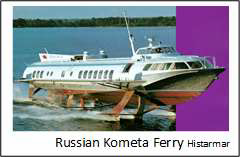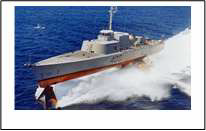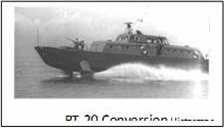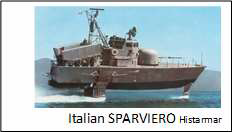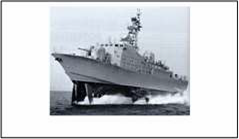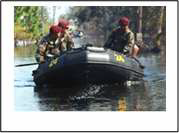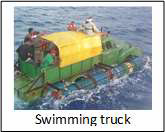Volume 3: Naval Systems
Contents
Chapter 1: Littoral Systems
This chapter focuses on vessels for use in littoral ("near the shore") operations. Littoral activities include the following:
- "brown water" naval operations in coastal waters (out to as far as 200+ km from shore),
- amphibious landing operations or port entry (opposed and unopposed),
- coastal defense actions (including patrols, engaging enemy, and denying entry)
- operations in inland waterways (rivers, lakes, etc), and
- actions in large marshy or swampy areas.
There is no set distance for “brown water.” Littoral range is highly dependent on specific geography at any point along a coast. Littoral operations can be highly risky. Forces moving in water are often challenged by nature and must move at a slow pace while exposed to enemy observation and fires. Thus littoral forces will employ equipment best suited for well-planned operations with speed, coordination, and combined arms support. Littoral forces will employ a mix of conventional forces, specialized (naval, air, and ground) forces and equipment, and civilian equipment which can be acquired or recruited for the effort. Each type of action may require a different mix of equipment to deal with challenges of terrain, vulnerability, and enemy capabilities.
Coastal water operations can utilize naval vessels that can operate in blue water. Naval battle groups for deep water also operate in littoral waters. Submarines and anti-submarine warfare (ASW) systems conduct missions in littoral waters. But challenges of shallow waters and shoreline threats also require use of smaller fast-attack boats, patrol craft, cutters, etc. Other craft include tug and maintenance boats, amphibious aircraft, and submarines. Many of the surface vessels in Chapter 1 are designed for littoral operations. Newer technologies are contributing to vessel designs for littoral waters. Along coastal areas, naval craft support ground forces by transporting troops and supplies as needed. For patrols in search of enemy and smuggler activities, stealthy high-speed craft are valuable assets. Paramilitary, police, security force, and other authorized agency craft will also operate in these waters. Most vessels in these waters are civilian commercial watercraft (for shoreline maintenance, fishing, and transport) and private pleasure craft. Insurgent forces and smugglers use these craft and may even “hide in plain sight.”
Amphibious landing operations need additional vessels, including landing craft, and shallow water close-in fire support craft to suppress ground targets and provide air defense. Air cushion landing craft (aka landing craft air cushion – LCAC) offer speed and agility to insert assets early in an operation. Other equipment includes unmanned underwater vessels (UUVs) for vessel inspection, reconnaissance, etc. Assets include special purpose forces (SPF), with specialized equipment, such as coastal infiltration submarines, midget submarines, scuba gear, semi-submersible infiltration landing craft, and mother ships for surreptitious launch. Aircraft support missions include anti-ship and anti-landing fires, surveillance, and transport. Inflatable boats (modular, rigid, and rigid-hulled) are widely used.
Most vehicles classified as amphibious are not really designed to operate in sea state 3 or greater. Thus they must be used in fairly calm waters or launched close to shore from landing craft.
Modern Technologies in Littoral Craft Design
There are several modern technologies for vessel design which offer more rapid movement for executing military operations. Some of these are quite costly, or are more suitable for calmer littoral waters, higher mission rates over shorter operating range, or for use in specialized missions.
Hydrofoils are increasingly used in commercial ferries, which can be exploited for military use. Some military patrol craft forces, including U.S. and Russian examples, feature hydrofoils. Discussion of this technology can be found below.
Another modern technology for modern craft is the air cavity hull design. With a scalloped cross-section, catamaran and trimaran designs mean that much of the hull is above the waterline, for reduced drag and shallower draft. These designs are increasingly being used in the commercial sector for sail craft and for racing boats. They also offer wider hulls for better stability over the waves, and more space to carry wide loads. They are popular for ferries and other roles carrying wide loads, such as vehicles. Capabilities for higher speed, dependable operation (with no need for mechanisms which can fail, e.g., hydrofoils), a stable platform, and shallow draft mean that coastal patrol and attack craft can use this design. A further development of the air cavity design technology is the addition of wave-piercing sponsons with hydra-jet propulsion. Despite higher cost, air cavity vessels are likely for use in littoral and some blue water roles.
Air cushion vessels can operate in coastal areas with irregular shore line and shallows. They are noted below for amphibious landing use, but can also be used as patrol craft, and to provide high speed transport in coastal zones.
Another littoral military technology is wing-in-ground effect (WIG) craft, which use lifting thrust for flight 1- 2 meters above the waves, and propelling thrust for missions at speeds of up to 700 km/hr. A few Russian WIG craft were equipped with missiles to attack ships, and with large compartments to deliver troops and equipment. Due to military fielding and operational cost issues, most of the large Russian military “Ekranoplans” are no longer in use. However, successful peacetime conversions include the Orlyonok (with
140 ton displacement, speed 220 knots, range 830 nm). It is now used for passenger and cargo transportation, but could be employed for military roles. Commercial developers in various countries offer smaller WIG craft for passenger and cargo transport, and for personal use.
Inland waterways permit use of new technologies designed for commercial and recreational uses. Military requirements for riverine craft include high speed, rapid maneuver, shallow water capability, space for weapon mounts, and more. Airboats can operate in rivers and creeks and in marshy areas with a few inches of water. Ski boats, “cigar boats,” and other high-speed designs offer potential for military applications.
Hydrofoil Craft for Littoral Operations
This technology is increasingly being used for boats and ships in both commercial and military sectors. It is an expensive propulsion upgrade because of the mechanisms required, but the benefits are in open water speed. For ferries and medium range transport, shorter passage time can mean more passages and missions completed. For military applications, speed also decreases exposure time and permits quicker response time to engage targets. When in harbor areas or shallow water, foils are folded for conventional
hull down propulsion. Wave action in high sea state open water will affect craft designed for coastal waters, as is true with any conventional designs.
Military craft using foils are currently limited to craft for littoral operations. However, new hydrofoil designs are being considered for larger blue-water vessels. Military craft have been used by the U.S., Russia, Italy, Philippines, Israel, and others. A Canadian test of the Italian FHE-400 Bras’Dor 200-ton hydrofoil boat for anti-submarine warfare found it to be impressive in coastal waters, but unsuitable for long-term deep-water use under severe weather conditions.
Very Lightweight Craft for Use in Littoral Operations
Inflatable craft can fit in small spaces, with reduced weight for crew carry and transport. They fit stealthy operations with low profile (less visual signature), little metal for minimal radar and thermal signature, and low acoustic signature (low weight for smaller engines, and minimal sound of waves against a hull). They are also very cost effective. Inflation/re-inflation/ preparation times are reduced with compressed gas, pneumatic pumps, and cans of quick sealer.
These craft are popular in the sport industry, and are widely used in commercial roles. Thus there are many new technologies and hundreds of producers, most for non-military markets. Although rubber is still used; its use is far outnumbered by the variety of polyethylene watercraft available. Any of these products could have uses for military forces; however, military applications have some requirements that affect choices. Commercial boats often use bright colors for easy detection, versus military craft that are patterned to be concealable. Military craft are usually more rugged, to withstand wear and handle all men and gear needed on a mission. Military craft may need to support weapons mounts and more powerful engines.
Improved boat technologies have led to confusion in the terms used for the boats. The acronym RIB can mean rubber inflatable boat, rigid inflatable boat, and rigid-hulled inflatable boat. Zodiac and other commercial firms offer boats which can be deflated, easily shipped, then quickly re-inflated and placed into service. Non-rigid boats are well-suited for small teams and for portage off-road between uses. Improvised means for added rigidity include inserted rods, boards, plywood to add decking, and loose seats or packs. Oars are often used for clandestine and short crossings.
Rigid inflatable boats, often favored by military forces, can have rigid seats and decking, for less chance of puncture, better stability in heavier waves, and more carrying capacity. There are dozens of designs for sporting, commercial, and military use. Facilities on or near the water will more likely use these craft than the earlier types. Styrofoam fills add rigidity and prevent sinking.
Many military units now use rigid-hulled boats (RHIB), which can be stacked and quickly placed into service, and can handle bigger engines, more troops and supplies, and heavier seas. Inflatable sections extend freeboard, reduce spray and wave effects, and assure flotation in case of capsizing. A fiberglass hull also permits weapon mounts. Some of the boats use armor plate to protect against 7.62-mm rounds. To avoid confusion of terms, the Zodiac Company now refers to its basic rubber inflatable boats as modular inflatable boats (MIB); but it also offers rigid designs.
Rafts and boats can be towed or rowed, and improvised from random wood, cut from trees, or rigged with drums or bladders. Inflatable rafts assist missions and can be life rafts in emergencies. Craft like
canoes, kayaks, johnboats and bateaus can be expropriated for military use. Another option is folding commercial or assault boats with polypropylene or plywood panels, also used as pontoons.
Chapter 2: Surface Systems
Naval surface vessels vary widely, from aircraft carriers displacing tens of thousands of metric tons to meters-long rubber inflatable boats for littoral use. This chapter covers aircraft carriers and surface combatants. These vessels are designed to conduct overt attacks against naval, air, and/or ground targets or to perform patrol functions. The different types are listed below in order of decreasing tonnage. Of note, distinctions between the types have become blurred in recent years.
- Aircraft carrier: Displacing 18,00-102,000 metric tons, aircraft carriers serve as waterborne military air bases. Lightly-armed, their importance comes from the ability to move large numbers of fighter/attack aircraft around the globe and serve as self-contained bases for the same.
- Battleship: Once the greatest weapon on the seas, battleships could displace as much as 63,000 metric tons – more than some modern-day aircraft carriers. They were armed with heavy guns and used for ship-to-ship and ship-to-shore battles. The last active battleships were decommissioned in 1991.
- Cruiser: Usually displacing 5,000-11,000 metric tons, cruisers were originally fleet scout ships. They have since evolved into anti-air and anti-ship vessels, though some classes can also do shore bombardment. Larger platforms can displace as much as 27,000 metric tons and may be referred to as battle cruisers. These vessels are usually armed with heavy guns and a combination of missiles and/or torpedoes.
- Destroyer: Commonly displacing 4,000-10,000 metric tons, these ships were originally designed for anti-submarine (undersea) warfare. The role of modern destroyers has expanded to include anti-ship and anti-air functions. These vessels are usually armed with missiles, torpedoes, and heavy guns.
- Frigate: Originally used for scout and escort duties, modern frigates commonly displace around 3,000 metric tons and mainly perform anti-air and anti-submarine duties. These vessels are usually armed with a combination of missiles, torpedoes, depth charges, and guns.
- Corvette: Smaller than frigates, corvettes nonetheless perform similar duties. They displace approximately 1,000-1,500 metric tons and are usually armed with a combination of missiles, torpedoes, depth charges, and guns.
This chapter focuses on surface vessels that are capable of blue-water operations. Large patrol craft and smaller littoral vessels are covered in Chapter 1.
Chapter 3: Undersea Systems
Naval undersea vessels vary widely, from ballistic missile submarines displacing several thousand tons to meters-long semi-submersible craft for littoral use. There are several broad categories of undersea vessels, the most commonly known being the traditional submarine. Additional categories include midget submarines, submersibles, semi-submersibles, and unmanned underwater vessels (UUVs).
Most undersea vessels are designed to conduct overt attacks against naval and/or ground targets. Other roles played include coastal infiltration; intelligence, surveillance, and reconnaissance (ISR); mine warfare; research; salvage; search and rescue (SAR); and special purpose forces support functions such as swimmer delivery.
The primary types of “blue-water” submarines are attack submarines and strategic submarines. Attack submarines are designed to target naval vessels – surface, undersea, or both – and are armed with torpedoes and/or anti-ship missiles. These boats are increasingly being armed with ship-to-shore missiles as well. Strategic submarines fall into two main categories based on armament. Ballistic missile submarines, commonly known as “boomers,” are armed with intercontinental ballistic missiles, while guided missile submarines carry cruise missiles.
This chapter focuses primarily on undersea vessels capable of blue-water operations, and is currently limited to submarines. Littoral vessels, such as North Korea’s Semisubmersible Infiltration Landing Craft (SILC), are covered in Chapter 1 of this volume.
Chapter 4: Unconventional and SPF Surface and Undersea Systems
This chapter focuses on vessels for use in littoral ("near the shore") operations. Littoral activities include the following:
- "brown water" naval operations in coastal waters (out to as far as 200+ km from shore),
- amphibious landing operations or port entry (opposed and unopposed),
- coastal defense actions (including patrols, engaging enemy, and denying entry)
- operations in inland waterways (rivers, lakes, etc), and
- actions in large marshy or swampy areas.
There is no set distance for “brown water”. Littoral range is highly dependent on specific geography at any point along a coast. Littoral operations can be highly risky. Forces moving in water are often challenged by nature and must move at a slow pace while exposed to enemy observation and fires. Thus littoral forces will employ equipment best suited for well-planned operations with speed, coordination, and combined arms support. Littoral forces will employ a mix of conventional forces, specialized (naval, air, and ground) forces and equipment, and civilian equipment which can be acquired or recruited for the effort. Each type of action may require a different mix of equipment to deal with challenges of terrain, vulnerability, and enemy capabilities.
Coastal water operations can utilize naval vessels that can operate in blue water. Naval battle groups for deep water also operate in littoral waters. Submarines and anti-submarine warfare (ASW) systems conduct missions in littoral waters. But challenges of shallow waters and shoreline threats also require use of smaller fast-attack boats, patrol craft, cutters, etc. Other craft include tug and maintenance boats, amphibious aircraft, and submarines (Ch 2). Many of the surface vessels in Chapter 1 are designed for littoral operations. Newer technologies are contributing to vessel designs for littoral waters (see section at pg 3-6). Along coastal areas, naval craft support ground forces by transporting troops and supplies as needed. For patrols in search of enemy and smuggler activities, stealthy high-speed craft are valuable assets. Para-military, police, and security force and other authorized agency craft will also operate in these waters. Most vessels in these waters are civilian commercial watercraft (for shoreline maintenance, fishing, and transport) and private pleasure craft. Insurgent forces and smugglers use these craft and may even “hide in plain sight.”
Amphibious landing operations need additional vessels, including landing craft, and shallow water close-in fire support craft to suppress ground targets and provide air defense. Air cushion landing craft (aka landing craft air cushion – LCAC) offer speed and agility to insert assets early in an operation. Other equipment includes unmanned underwater vessels (UUVs) for vessel inspection, reconnaissance, etc. Assets include special purpose forces (SPF), with specialized equipment, such as coastal infiltration submarines (see Sang-O at pg 2-7), midget submarines, scuba gear, semi-submersible infiltration landing craft (pg 3-10 below), and mother ships for surreptitious launch. Aircraft support missions include anti-ship and anti- landing fires, surveillance, and transport. Inflatable boats (modular, rigid, and rigid-hulled) are widely used.
Most vehicles classified as amphibious are not really designed to operate in sea state 3 or greater.
Thus they must be used in fairly calm waters or launched close to shore from landing craft.
Many countries, however, have a fairly wide variety of vehicles for use in coastal amphibious operations. Some of the largest amphibious forces are in conventional army units that must operate in littoral zones. Thus they must have many vessels, special vehicles, and support assets. Combat vehicles for amphibious operations include selected IFVs and APCs (Vol 1 pg 3-41), light tanks and other heavy armored combat vehicles (HACVs, Vol 1 pgs 6-42 through 58). Chinese forces have added several fighting vehicles with buoyant front compartments for use in high sea states. These include the Type 90 APC, ZBD2000 IFV, and Type 63AM (aka Type 99) light amphibious tank. Highly amphibious combat support vehicles (CSVs) include the U.S. DUKW and the Russian PTS-M. Support equipment includes bladders to attach to vehicles and equipment, and amphibious trailers, such as the Russian PKP (for use on land and water).
Coastal defense forces include conventional units and weapons. Many ATGMs can destroy naval vessels (including NLOS systems, Vol 1 pg 6-75). Specialized weapons include anti-ship missile systems, e.g., Harpy, HY-2/SILKWORM, and supersonic missile BrahMos (Vol 2, pg 5-14). Other specialized systems include aircraft and anti-ship artillery systems (like the Russian Bereg SP cannon system). Torpedoes (such as the high-speed Shkval-E) can be launched from ships or underwater launchers to destroy vessels. Air defense missile systems, e.g., Russian SA-11 and Buk-M1-2 (Vol 2, pg 6-78), can be used as anti-ship missiles. Naval aircraft (e.g., the Russian Ka-27/HELIX) and UAVs can be used for coastal defense forces. Engineers and other support units will emplace obstacle systems underwater and ashore at likely landing areas. Surface and subsurface minefields will target surface vessels and submarines, and slow and channelize movement. Anti-landing mines are laid close to shore and at landing sites. Remote mine and rocket launchers deliver fires and strikes at landing craft and vehicles attempting to breach gaps in obstacle systems. Missile, gun, and rocket weapons will deliver precision strikes. Unmanned surface vessels with remote operated weapons can patrol and attack enemy targets.
Most large military forces conducting large military offensive operations will use ports to bring in forces or support the forces. The OPFOR will focus great effort to deny waterborne early entry and prevent sustained embarkation operations. They will use all available air, land, and naval forces. They will attack the force at critical nodes such as restricted waterways, including straits, channels, canals, harbors, and in port areas, to destroy the force and deny facilities. Mines, torpedoes, submarines, fast-attack craft, SPF, insurgents, and other means will be used.
Crossings in inland waterways are described in Army Field Manual 7-100.2 (Chapter 12). Factors such as gap width, depth, water speed, and threat (whether the crossing is opposed, etc.) affect the choice of equipment used. Coastal patrol, fast-attack, and landing craft can be used in inland waterways. Shallow- draft military riverine craft and commercial boats are widely used.
Airboats can move quickly, even in the shallowest waters. Barges can mount weapons and supplement carrying capacity of vessels. Amphibious vehicles are widely used. Improvised swim assists such as bladders and barrels enable equipment and vehicles to cross water gaps. Hydro-propulsion water-craft and craft with snag protection are widely used. Jet skis (aka wave runners) can be adapted for military use, even mounting weapons and operating rapidly in shallow waters. Seaplanes and aircraft fitted with pontoons can access areas difficult to reach by land.
Engineer assets are used in gap crossings. Reconnaissance assets, e.g., Russian IRM armored reconnaissance vehicles, frogmen with Scuba gear, re-breathers, mini-subs, and underwater propulsion units, shoreline recon units, and underwater maps help prepare a crossing.
Atmospheric diving suits (ADS) are used in all waters for longer-duration underwater work (deep sea diving, ship and harbor repair, surveillance, and engineer work). Civilian divers will also be used. Bridge vehicles can be used for narrow crossings. Pontoons, amphibious transporters and ferries can be used for wider gaps. Boats and amphibious trailers are used.
Pioneer units and others use improvised assets to aid in crossings. Inflatable rafts and improvised aids, such as wooden rafts constructed from nearby timber and structures, will be used to supplement military assets. Boats can be lashed together to substitute for pontoons as improvised bridges. They may even be planked with boards to support vehicles and equipment.
Mechanized amphibious units will include companies and battalions organized and equipped for use in opposed crossings. These units are carefully coordinated with supporting units to use deception, surprise, supporting fires (direct and indirect), and rapid maneuver to cross and to seize the other shore. Assets will include armored amphibious vehicles, fire support vehicles, and other support systems with amphibious capabilities. Aircraft and airborne/air assault assets will be used if available. Water-borne assets will attempt to expand the crossing area and bridge the gap (if needed for support assets to cross). Engineer ferries and transporters can be used once the site is secured. Non-swimming vehicles with high- ford designs and snorkels can be used in many crossings. Some tanks with snorkels can ford in waters to 5 m in depth. Winches on fording vehicles aid in navigating narrow water crossings.
Defense of inland waterways is primarily executed with conventional units. Additional equipment can include crossing assets (above, such as commercial watercraft, and anti-landing mines). The Russian KPDM-4 cassette anti-landing mine system offers 50-m ground launch range, for concealed or defilade launch. The VSM-1 helicopter minelayer can also be used.
Marshy and swampy areas require a mix of boats and vehicles that can move in very shallow waters. Airboats and tracked vehicles designed for very low ground pressures can be useful for rapid movement in these areas. The Ukrainian/Russian MT-LB armored transporter, and the Swedish Bv-206 are far-better suited for these terrains. Wheeled vehicles are poorly suited for this terrain. Even many amphibious tracked vehicles cannot be used in these areas, due to excessive ground pressure. In areas with 1 to 3 feet of water with muddy bottoms and banks, and some obstruction (stumps, brush, etc.), vehicles may find the going very slow. Winches, hoists, and saws are critical assets for pulling out vehicles and clearing obstructions. Engineer road clearing and reconnaissance vehicles (Vol 1, pgs 8-37 thru 41) can help. A wide array of other support and combat support assets can be used in littoral missions, including water crossings and actions in nearby land areas (including ports, coasts, and marshy or sandy areas).
Improvised assets are used by civilians in marshy areas, and will be exploited by military forces. Large numbers of flat-bottom boats, amphibious ATVs (such as Supacat, Vol 1, pg 3-73), and dismounted infantry are needed. So-called “swamp buggies” can be fashioned from trucks and tractors with large wide
wheels for low ground pressure and high ground clearance. They can transport assets, free mired vehicles, and be fashioned into “technicals” for fire support.
Modern Technologies in Littoral Craft Design
There are several modern technologies for vessel design which offer more rapid movement for executing military operations. Some of these are quite costly, or are more suitable for calmer littoral waters, higher mission rates over shorter operating range, or for use in specialized missions.
Hydrofoils are increasingly used in commercial ferries, which can be exploited for military use. Some military patrol craft forces, including U.S. and Russian examples, feature hydrofoils. Discussion of this technology can be found on page 3-7.
Another modern technology for modern craft is the air cavity hull design. With a scalloped cross- section, catamaran and trimaran designs mean that much of the hull is above the waterline, for reduced drag and shallower draft. These designs are increasingly being used in the commercial sector for sail craft and for racing boats. They also offer wider hulls for better stability over the waves, and more space to carry wide loads. They are popular for ferries and other roles carrying wide loads, such as vehicles. Capabilities for higher speed, dependable operation (with no need for mechanisms which can fail, e.g., hydrofoils), a stable platform, and shallow draft mean that coastal patrol and attack craft can use this design. The Chinese C-14/China Cat catamaran missile boat has proven to be an effective design (pg 3-8). Transport craft include the Russian Linda, at 25 tons, with a passenger load of 70, and speed of 31 knots, successfully operating in shallow waters.
A further development of the air cavity design technology is the Chinese HOUBEI-Class/Type 022 catamaran missile fast attack craft. Derived from Australian ferries, these 220-metric ton vessels feature two wave-piercing sponsons with hydra-jet propulsion. Thus they can be armed with an impressive weapons array while operating at speeds up to 36 knots even in deep water. Despite higher cost, air cavity vessels are likely for use in littoral and some blue water roles.
Air cushion vessels can operate in coastal areas with irregular shore line and shallows. They are noted below for amphibious landing use, but can also be used as patrol craft (Russian Sivuch, pg 1-12 and ZUBR at 3-9), and to provide high speed transport in coastal zones.
Another littoral military technology is wing-in-ground effect (WIG) craft, which use lifting thrust for flight 1-2 meters above the waves, and propelling thrust for missions at speeds of up to 700 km/hr. A few Russian WIG craft such as the Caspian Sea Monster were equipped with missiles to attack ships, and with large compartments to deliver troops and equipment. Due to military fielding and operational cost issues, most of the large Russian military “Ekranoplans” are no longer in use. However, successful peacetime conversions include the Orlyonok (with 140 ton displacement, speed 220 knots, range 830 nm). It is now used for passenger and cargo transportation, but could be employed for military roles. Commercial developers in various countries offer smaller WIG craft for passenger and cargo transport, and for personal use.
Inland waterways permit use of new technologies designed for commercial and recreational uses. Military requirements for riverine craft include high speed, rapid maneuver, shallow water capability, space for weapon mounts, and more. Airboats can operate in rivers and creeks and in marshy areas with a few inches of water. Ski boats, “cigar boats” and other high-speed designs offer potential for military applications. These technologies will be described in later updates.
This technology is increasingly being used for boats and ships in both commercial and military sectors. It is an expensive propulsion upgrade because of the mechanisms required, but the benefits are in open water speed. For ferries and medium range transport, shorter passage time can mean more passages and missions completed. For military applications, speed also decreases exposure time and permits quicker response time to engage targets. When in harbor areas or shallow water, foils are folded for conventional hull down propulsion. Wave action in high sea state open water will affect craft designed for coastal waters, as is true with any conventional designs.
Military craft using foils are currently limited to craft for littoral operations. However, new hydrofoil designs are being considered for larger blue-water vessels. Military craft have been used by the U.S., Russia, Italy, Philippines, Israel, and others. A Canadian test of the Italian FHE-400 Bras’Dor 200-ton hydrofoil boat for anti-submarine warfare found it to be impressive in coastal waters, but unsuitable for long-term deep-water use under severe weather conditions.
One of the early commercial hydrofoil craft was the Italian Supramar design licensed to the Rodriquez shipyard as the PT-20. This craft is highly successful and used around the world. The 72-passenger ferry displaces 32 tons, for a speed of 35 knots. Military conversions such as the Philippine patrol craft noted at right continue to operate.
The Italian SPARVIERO Class includes seven fast-attack craft, first delivered in 1974. With 62.5 tons of displacement, speed is 50 knots foil-borne, 8 foils folded. Range is 2,225 km. The boat has a 76 mm OTO-Melara cannon and two Otomat anti-ship missile launchers.
Russian ANTARES-Class patrol boats from the 1970s and 80s are among several designs currently in operation. They displace 220 tons, with a max speed of 65 knots, and can operate in 3-meter waves. Hull-borne, it can operate in sea state 7. Range is 410 nm. Weapons include a 76-mm gun, a 30-mm 6- barrel Gatling-type gun, and two torpedo tubes. Other Russian hydrofoil vessels include SOKOL-Class ships of 465 tons.
Very Lightweight Craft for Use in Littoral Operations
Inflatable craft can fit in small spaces, with reduced weight for crew carry and transport. They fit stealthy operations with low profile (less visual signature), little metal for minimal radar and thermal signature, and low acoustic signature (low weight for smaller engines, and minimal sound of waves against a hull). They are also very cost effective. Inflation/re-inflation/ preparation times are reduced with compressed gas, pneumatic pumps, and cans of quick sealer.
These craft are popular in the sport industry, and are widely used in commercial roles. Thus there are many new technologies and hundreds of producers, most for non-military markets. Although rubber is still used; its use is far outnumbered by the variety of polyethylene watercraft available. Any of these products could have uses for military forces; however, military applications have some requirements that affect choices. Commercial boats often use bright colors for easy detection, versus military craft that are patterned to be concealable. Military craft are usually more rugged, to withstand wear and handle all men and gear needed on a mission. Military craft may need to support weapons mounts and more powerful engines.
Improved boat technologies have led to confusion in the terms used for the boats. The acronym RIB can mean rubber inflatable boat, rigid inflatable boat, and rigid-hulled inflatable boat. Zodiac and other commercial firms offer boats which can be deflated, easily shipped, then quickly re-inflated and placed into service. Non-rigid boats are well-suited for small teams and for portage off-road between uses. Improvised means for added rigidity include inserted rods, boards, plywood to add decking, and loose seats or packs. Oars are often used for clandestine and short crossings.
Rigid inflatable boats, often favored by military forces, can have rigid seats and decking, for less chance of puncture, better stability in heavier waves, and more carrying capacity. There are dozens of designs for sporting, commercial, and military use. Facilities on or near the water will more likely use these craft than the earlier types. Styrofoam fills add rigidity and prevent sinking.
Many military units now use rigid-hulled inflatable boats (RHIB), which can be stacked and quickly placed into service, and can handle bigger engines, more troops and supplies, and heavier seas. Inflatable
sections extend freeboard, reduce spray and wave effects, and assure flotation in case of capsizing. A fiberglass hull also permits weapon mounts. Some of the boats use armor plate to protect against 7.62-mm rounds. To avoid confusion of terms, the Zodiac Company now refers to its basic rubber inflatable boats as modular inflatable boats (MIB); but it also offers rigid designs.
Rafts and boats can be towed or rowed, and improvised from random wood, cut from trees, or rigged with drums or bladders. Inflatable rafts assist missions and can be life rafts in emergencies. Craft like canoes, kayaks, johnboats and bateaus can be expropriated for military use. Another option is folding commercial or assault boats with polypropylene or plywood panels, also used as pontoons.

